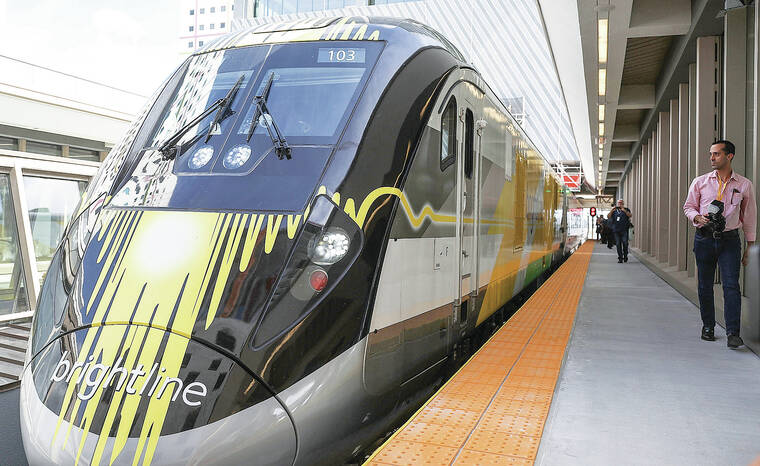New high-speed train from Vegas to SoCal will be a model for the nation — if it succeeds
MIAMI — When Simon Akinwolere, a 27-year-old cruise director, needed to commute from Orlando to Miami, he sorted through his travel options.
He could drive the 235 miles, spending four hours dealing with traffic, stress, lost work time and gas stops. Flying would be faster, but he’d endure security lines and baggage hassles at two busy airports.
ADVERTISING
He settled on a new, third option: Buy a train ticket that promised a 3½-hour ride, access to a conference room and a free buffet with self-serve beer and wine taps.
A privately run train line between Orlando and Miami called Brightline has become Akinwolere’s favorite way to shuttle between the two Florida cities since the new long-haul service started in September.
“I come from England, so trains are my bag,” he said, explaining his decision to pay $149 for a one-way, first-class seat on his way to catch a Miami flight to Cozumel, Mexico.
President Joe Biden is depending on people such as Akinwolere — and more than a few additional American converts — to realize the long-forestalled dream of revitalizing passenger rail service in this country. Biden, a train enthusiast who spent his Senate career commuting from Washington to Delaware on Amtrak, sees rail travel as central to his legacy.
Florida’s train, which reaches speeds up to 125 mph, is owned by Brightline, the same company behind an even more ambitious test project: Brightline West, a $12-billion, 218-mile route between Las Vegas and Rancho Cucamonga that promises even faster travel as the first true high-speed rail line in the United States.
Brightline executives are hoping to open the western route, with speeds up to 200 mph, by 2028, in time for the Los Angeles Olympics. They plan to break ground in the spring if they complete financing.
The Biden administration is pumping $3 billion in taxpayer dollars into the project, along with access to $3.5 billion in tax-exempt bonds, in hopes that a private company can execute what a slew of public bullet-train ventures have so far failed to accomplish, including California’s long-delayed project from San Francisco to Los Angeles.
“Our goal is that this is the train that primes the pump,” said Wes Edens, a private equity billionaire and founder and chairman of Brightline. “Once you have proof of this one, many more will follow.”
Specialists who’ve studied the Brightline West project — the only high-speed rail project with labor deals, right-of-way access and environmental permitting completed — say it holds a better chance of success than the California high-speed rail route from L.A. to San Francisco, a publicly funded project. But they are not uniformly sold.
“I wish them well,” said Robert Poole, director of transportation policy for the libertarian-leaning Reason Foundation and a Florida resident who has become a big booster of the project there. “I hope the plan works, but I’m skeptical.”
•••
CAN RAIL COMPETE WITH CHEAP U.S. HIGHWAYS?
There are reasons high-speed lines in the U.S. have faltered while those in Europe and Asia thrive.
American population centers tend to be spread farther apart. U.S. cities are often designed around highway exits rather than transit systems that connect people to train stations. Driving here is cheaper than in other parts of the world, where gas taxes, tolls and congestion fees are higher.
American passenger trains have to compete for access with lumbering freight trains on single track systems, which are more congested than Europe’s multi-track railroads.
And Americans, accustomed to having their taxes pay for large interstate highways, are not conditioned to spending the billions of dollars it takes to help build and operate trains.
Brightline’s executives say they’ve traveled to Britain, France, Spain and Japan to absorb all the right lessons, choosing routes that can be built with fewer legal fights over land and environmental impacts.
And they say they have found the sweet spots on the map to make these rail projects work: connecting two points short enough to beat air travel times, but long and dense enough to attract drivers seeking less stressful rides.
The company estimates that 50 million people per year travel between Southern California and Las Vegas, more than 40 million of them in cars.
“They’ll have to drive past our train station and then watch the trains whiz by them at 220 mph” while they’re stuck in traffic, Edens said. “It’ll be phenomenal.”
It sounds good on paper, but the Florida venture has yet to meet ridership projections since it launched in 2018, with more limited service from Miami to Fort Lauderdale and West Palm Beach, two nearby cities to the north.
It had an operating loss of $190 million during the first nine months of last year as it prepared for the big expansion to Orlando, according to a public bond filing.
Brightline West faces additional challenges.
The two-hour route from Las Vegas to Southern California has to overcome steep changes in elevation, which pose special construction and engineering challenges.
The route ends in Rancho Cucamonga in San Bernardino County, about 40 miles east of downtown Los Angeles. That means many riders would either have to take a slower MetroLink rail connection to downtown, or face a 1- to 2-hour drive, depending on traffic. And to make money, Edens said he will eventually charge more than $400 for a round trip from Las Vegas to Rancho Cucamonga, suggesting Biden’s vision for high-speed rail may not be affordable for many people.
•••
INSIDE BRIGHTLINE
During an interview in the station’s first-class lounge, Michael Reininger, Brightline’s chief executive, said they do not yet know what they will do with the 300 acres they own in Victor Valley in San Bernardino County and the 110 acres the company owns around the Las Vegas station. But the possibilities are vast, especially for what they say is the largest contiguous piece of undeveloped land on the Strip.
An investment group is already planning to build an arena next door to the Vegas station in hopes of winning an NBA franchise, which could further enhance the value and draw more riders. Though Edens is not part of the investment group, he stands to benefit.
Brightline uses events in Florida, including basketball game packages, to lure new customers, a central piece of the plan for Las Vegas.
•••
COMPLAINTS ABOUT DEATHS, NOISY WHISTLES
The biggest complaints about the Florida train have come from residents in communities that have train noise and rail crossings but don’t have access to stations. Lawsuits over safety and environmental issues were resolved with a promise to build an additional station in southeast Florida’s Treasure Coast, about two hours north of Miami, and to spend millions more on safety around the tracks.
“The train is here. We have 32 runs a day. People are not too pleased,” said Joseph Flescher, a commissioner in Indian River County, the former spring training home of the Dodgers, which is not in the running for a station.
Flescher and his colleagues have heard from residents seeking to reduce the number of noisy train whistles. But he said commissioners are more concerned about safety.
More than 100 people have been killed by Brightline trains since the Florida service began testing in 2017. That’s more deaths per mile traveled than any other train in the country, according to an ongoing analysis by the Associated Press.
The deaths mostly have been the result of people walking in the right-of-way, often intentionally as a method of suicide, or driving around crossing gates, hoping to beat the train. Brightline and the state have been spending millions to build more and stronger barriers while police are increasing ticketing.
The Brightline West project is unlikely to carry the same fatality risks because it will be built largely in the median along Interstate 15, between 4-foot-high concrete walls. Also, because the track is electrified, it will not have any grade crossings, Reininger said.
“There’s only us in that completely sealed corridor, the whole way,” he said. “So it’s fundamentally a different configuration.”
The plan to build in the median is one of the main reasons the project will be easier to develop than California high-speed rail, which has been mired in questions over its viability amid cost overruns and delays. That project cuts through urban areas, requiring land acquisition and additional approvals. Brightline West goes through isolated deserts for most of its journey.
Experts and Brightline executives also say Brightline can be more nimble as a private company that is not subject to the political demands that have cost the public high-speed rail project money and time.
That has allowed the company to make some tough decisions, such as terminating the line in Rancho Cucamonga instead of Los Angeles. Reininger said “in a perfect world” he would have pushed into Union Station downtown, but pointed to numerous obstacles, including the lack of right-of-way space and the difficulty of electrifying tracks through an urban corridor, all of which would increase the cost and time significantly.
“The private sector alone does not guarantee a project’s success,” said Adie Tomer, a transportation and infrastructure specialist at Brookings Institution, a Washington think tank.
But the Biden administration is funding both models because “we’re in that stage where we’re building evidence of what works best in America,” which could build overall public support, he said.
It does have complications, however. The train will have to pass through two elevations, the Mountain Pass outside Las Vegas and the Cajon Pass in Southern California.
Reininger said the trains will slow to between 85 mph and 100 mph as they go up and down the passes, but using the existing highway infrastructure will ease the engineering hurdle.
“It’s not through the Alps,” Reininger said. But the company has modeled its practices “after the best of what we observed elsewhere, in particular Europe.”
Nick Little, director of railway education at the Center for Railway Research and Education at Michigan State University, sees that segment as the biggest question mark.
“My concern is that high-speed rail through the mountains on hilly and curvy track is a big challenge,” said Little, who believes the train line is unlikely to turn a profit for as many as 25 years, given the level of investment required.
The last 30 minutes of the trip from Miami to Orlando are the most exciting part. The train makes a turn from the original Flagler tracks, about 20 miles south of Kennedy Space Center, toward Orlando’s airport. This is the only new section of the route and it’s where Brightline tested using the highway median.
The train becomes noticeably faster — up to 125 mph — until it finally reaches the airport, bypassing all the cars.





